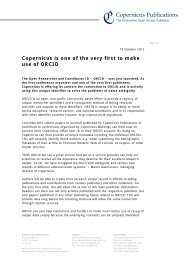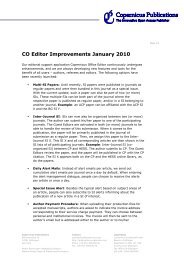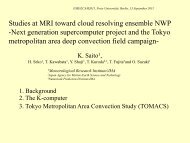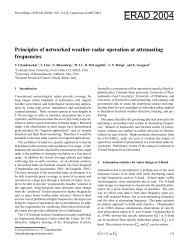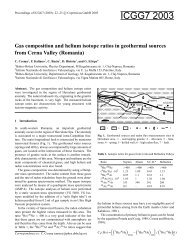ERAD 2002
ERAD 2002
ERAD 2002
You also want an ePaper? Increase the reach of your titles
YUMPU automatically turns print PDFs into web optimized ePapers that Google loves.
K. Friedrich and M. Hagen: Vector fields using a bistatic Doppler radar 209<br />
Fig. 4. Horizontal cross–section of F (∇Z) (color–coded) calculated<br />
for a convective cell. The isolines indicating the gradient of<br />
reflectivity factor are plotted every 5 dBZ starting at the outside of<br />
the cell with the 5 dBZ–isoline.<br />
absolute measurement, low wind–speeds create low values<br />
of F (σ ′ |Vh|/|Vh|). In addition, high standard deviations,<br />
e.g. close to the baseline or in the quasi–monostatic area,<br />
cause low values of F (σ ′ |Vh|/|Vh|). The influence of<br />
F (σ ′ |Vh|/|Vh|) on the average quality–control field is controlled<br />
by the weight of W F (σ ′ |Vh |/|Vh|).<br />
The weight of this quality–index field on the average<br />
quality–index field should be set low within those<br />
weather conditions having high wind–shear. For example,<br />
as illustrated in Fig. 5b at an azimuth angle of<br />
200 ◦ ≤ φt ≤ 225 ◦ and at a range of r ′ t = 20 km – 25 km, the<br />
wind–speed is very weak and causes F (σ ′ |Vh|/|Vh|) to be<br />
close to zero, even though σ ′ |Vh| is low and the wind represents<br />
realistic conditions within this area. To avoid a wrong<br />
interpretation of F (σ ′ |Vh|/|Vh|), W F (σ ′ |Vh |/|Vh|) should be<br />
set high during stratiform precipitation with wind–speed values<br />
larger than 5 m s −1 and low during situations with high<br />
wind–shear, e.g. convective situations.<br />
The fractional uncertainty can also be applied to the direction<br />
of the horizontal wind.<br />
3.2.4 Utilizing data consistency based on a persistence<br />
check<br />
The persistence check algorithm should help in identifying<br />
regions where wind–shear is higher than the mean flow. The<br />
regions identified are then tracked in space by means of<br />
wind–fields at different elevations and at different time steps<br />
(e.g. successive volume–scans). When high wind–shear is<br />
identified at different levels and/or in the successive volume–<br />
scans, the wind–shear can be related to atmospherical processes.<br />
Otherwise, the perturbation is removed.<br />
The persistence check is carried out as follows. The standard<br />
deviation in the horizontal wind–velocity, σ |Vh|, and<br />
(a) (b)<br />
Fig. 5. Horizontal cross–section of (a) the horizontal wind–vector<br />
of the simulated convective cell and (b) the respective quality–index<br />
field F (σ ′ |V h|/|Vh|). The 5 dBZ–isoline indicating the shape of<br />
the supercell storm is marked.<br />
Fig. 6. Horizontal cross–section of the horizontal wind–vector in<br />
m s −1 a convective storm. The area with wind–shear (direction<br />
and absolute value) higher than mean flow is marked. The 5 dBZ–<br />
isoline indicating the shape of the storm is marked.<br />
direction are calculated. The area is marked, when the difference<br />
between the mean value, Vh, minus the i ′ th measured<br />
horizontal wind–vector, Vi is larger than the vector<br />
standard deviation, σVh . For the horizontal wind–velocity<br />
this is given as<br />
σ |Vh| − |Vh − V i | ≤ 0 . (5)<br />
Figure 6 shows an example of how this algorithm is applied<br />
using the horizontal wind–field of a convective storm.<br />
The shape of the supercell storm is indicated by the 5 dBZ–<br />
isoline. The wind–shear within the storm is much higher than<br />
the surrounding air flow. Therefore, the area having high<br />
wind–shear is marked. Note that if the area marked gray is<br />
present in the successive volume scans as well as at neighboring<br />
levels, the marked area can then be identified as a signal<br />
which is related to meteorological processes. Otherwise,<br />
wind–vectors within this area will be removed.




